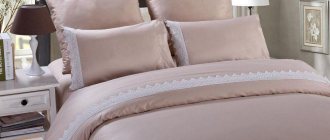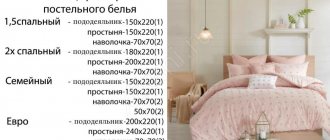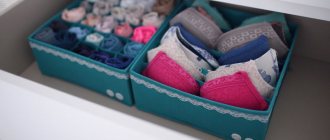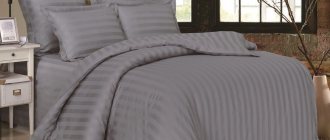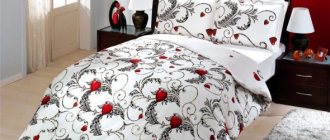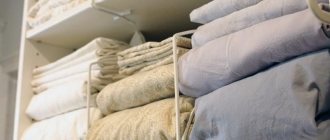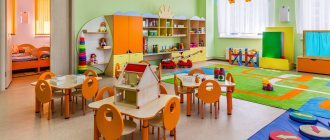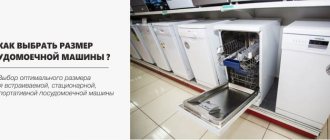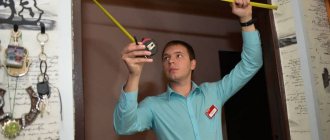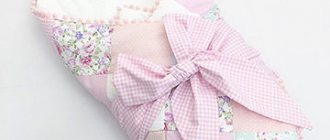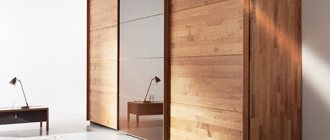Children's bedding is a special type of bedding that parents pay special attention to when purchasing. To make children's bedding sets, we use safe and high-quality materials, both synthetic and natural. A child is constantly developing, and therefore, as children grow older, they need the correct size pillowcases, duvet covers and sheets.
To choose the right set, you need to take into account the height and age of the child, and the dimensions of the bed. Parents should keep in mind that it is much easier to choose bedding for standard-shaped products.
Types of children's bedding sets and requirements for them
Children should feel comfortable in their bed.
As with any children's products, very high demands are placed on bed linen regarding hygiene, thermoregulation, and general safety. A quality product must:
- Help keep warm, but not contribute to overheating, which is dangerous, in particular for babies.
- High-quality materials should not interfere with free air exchange in order to avoid excess sweating, diaper rash and related problems.
- Good linen is hygroscopic, that is, it absorbs excess moisture, quickly evaporates it and at the same time retains heat.
- Hypoallergenicity is extremely important - at the slightest manifestation of itching, sneezing and other symptoms, it is necessary to change the bedding, if this is the case.
- Easy to care for – any baby clothes need regular cleaning and washing. If parents choose demanding, capricious materials, it is a good idea to invest money from the family budget into a local dry cleaner.
On sale you can find the following products that meet the most stringent quality standards:
- sets for newborns;
- linens for babies in a crib;
- kindergarten kits;
- blankets for schoolchildren and teenagers;
- double sets;
- non-standard sizes - made to order or sewn personally by parents as part of needlework.
Recommended materials
Pay special attention to the type of fibers used to make the fabric. Only natural materials such as cotton, linen, and silk meet the high requirements for children's underwear. Also included in this category is bamboo, a fiber that can become a worthy replacement for cotton.
To sew children's sleeping sets, five types of fabric are most often used, which are based on natural fibers.
- Chintz. Lightweight fabric made from cotton. This material is most often used for summer bedding sets. But it will be too heavy for a small child.
- Satin. Smooth, beautiful fabric. Usually made from silk fiber. But sometimes, in order to reduce the cost, cotton is used. Thanks to a special satin weave, this bed has a shiny surface and is pleasant to the body.
- Calico. Affordable, dense fabric made from cotton. This is a traditional material for bedding.
- Ranfors. This fabric is an improved version of calico, invented in Turkey. The material has increased density and is smooth.
- Percale. One of the strongest fabrics, yet pleasant to the touch. According to reviews, such linen will withstand many washes.
Sometimes bed linen contains not only a natural component, but also a synthetic one, called polyester. This is not something to be afraid of. A small amount of synthetic fiber allows you to reduce the cost of the product, provides better ironing, and prevents creasing.
About blankets and duvet covers
A blanket is a cozy, versatile and practical bedding that will be useful to your baby from the first days of life. Comfortable transformable blankets for discharge and for first walks, summer and winter options - all these things are designed to improve the quality of sleep, make the child’s life and growth healthy, and every new day active and full of discoveries.
The right duvet cover can not only extend the life of the duvet, but also improve your baby's sleep, health and overall quality of life. When choosing children's products, three parameters are most important: the age and height of the child, as well as the size of the bed. Let's take a closer look at standard models of blankets and duvet covers for different ages and situations. Standard sizes are very simple and convenient - textiles in this group can be freely purchased in theme stores and even in supermarkets. It is easy to select duvet covers for standardized models of blankets - just know the sizes.
Common dimensions of blankets:
- 110 cm by 140 cm;
- 100 cm by 135 cm;
- 60 cm by 120 cm.
Sets for cribs with railings must be chosen very carefully, because too small a product will not allow you to comfortably spread the blanket, and too large will cause all the linen to crumple and interfere with sleep.
It is believed that the simplest solution in this case would be to purchase a blanket measuring 60 cm by 120 cm - such a product almost completely covers the cribs for babies and does not cause any problems.
Typically, blankets of such a small size are double-sided and last only a few years, sometimes up to a year (due to the child’s growth characteristics). It is not always possible to easily find a ready-made duvet cover, but when buying or sewing it yourself, you need to make the linen a little larger; it is permissible to exceed the duvet parameters by 2-5 cm. This option is also suitable for strollers, since a compact duvet will not take up much space and will keep you warm , will cover and protect from sudden manifestations of bad weather.
It is important! Blankets for newborn babies cannot be chosen according to the principle “the more, the better.”
Large items are only suitable for walking, but are unsafe - they can unfold (therefore, it is better to use special envelopes with a fixation system for these purposes). Such things will not fit in the crib; at best, you will have to bend the edges. For the little ones, it is recommended to purchase two blankets - one directly for the bed, and the other for moving, playing, and so on.
For discharge, it is worth preparing a model of 110 cm by 140 cm - the experience of many young parents suggests that this is the optimal and practical option. It must be taken into account that discharge can happen at different times of the year, so you need to think about what material the blanket will be made of. There are demi-season and winter models. For a blanket of this format it is easy to choose ready-made linen. The optimal size of a duvet cover is 112 cm by 146 cm. Products of this format are quite durable, because they are also suitable for use in kindergarten.
Fuel consumption
When it comes to saving energy, consumers are primarily concerned with the question, what is the energy saving of this type of heating radiator? Again, a comparison will have to be made. To do this, let’s compare two brands of devices:
- the Cozy brand, well-known on the Russian market;
- and the no less popular Zilon.
The first model is an energy-saving battery, the second is a regular one.
So, the basis for selecting the power of any heating unit is a comparison of two indicators: heated area and thermal output. So, the optimal ratio is 100 W of heat per square meter of area, provided that the ceiling height in the house is 2.7-2.8 m.
Regular model
Zilon brand products are electric heating devices with a power of 2 kW, with which you can heat rooms with an area of 25 m². That is, to heat a house with a total area of 100 m², you will need four convectors with a total power consumption of 8 kW.
Economical device
To heat exactly the same house, you need 13 energy-saving Cozy brand radiators with a power of 0.25 kW each. In total, the power consumption will be only 3.25 kW. This is two and a half times less. But that's not all.
When the Cozy electric batteries are turned on, the devices operate in start-up mode until the normal room temperature set by you on the automation unit is reached inside the house. At this time, the rated power of 3.25 kW is consumed. After which the devices enter normal mode with reduced power consumption. The reduction is brought to 1.5 kW. Here's another savings of 2.5 times.
Sizes of blankets and duvet covers for schoolchildren and teenagers
For school-age children, one-and-a-half sets of standard sizes are suitable.
Schoolchildren already want to have their own space, their own room and personal belongings. Bed linen is no exception. Children prefer bright fabrics and fun designs. The following blankets are ideal for this age:
- 110 cm by 140 cm;
- 140 cm by 140 cm.
These are universal sizes, so it will not be difficult to choose suitable bedding for them, which usually exceeds the above parameters by several centimeters.
Important! When purchasing bedding for beds, blankets and pillows, it is enough to know the sizes of these accessories in order to choose pillowcases and duvet covers solely according to the sizes that the manufacturer indicates on the packaging.
Teenagers are practically independent adults, so the underwear for them is selected to be adult. To make a young man comfortable and warm in his bed, one-and-a-half sets of standard sizes are suitable:
- 140 cm by 205 cm;
- 150 cm by 200 cm;
- 160 cm by 210 cm.
For such products, ready-made bed linen of a pleasant design made from various textile materials is also available for sale. Typically, the sizes of duvet covers for them vary from 150 cm by 200 cm to 160 cm by 210 cm.
What's included in the newborn kits?
The birth of a child is a wonderful event in the life of every family. We try to give children the best: toys, clothes, entertainment. But it is very important from childhood that the baby is surrounded by natural fabrics that will not irritate his delicate skin. Cotton fully satisfies all these requirements, being a hypoallergenic and environmentally friendly material. It is important that all bedding sets for newborns are stitched with a linen seam and do not rub the delicate skin of the baby. Linen must comply with all sanitary and hygienic standards.
About pillows and pillowcases
A child over three years old needs a pillow.
A pillow is an important bedding item designed to support the child's head, cervical spine and spine in the correct position during sleep. The beauty of posture largely depends on her correct choice. The pillowcase should be practical, environmentally friendly and not have any of its own chemical industrial smell, because such an effect can interfere with healthy rest.
There are many different shapes and types of pillows that are used in children's rooms:
- orthopedic;
- traditional.
Pillows vary in shape:
- square;
- rectangle;
- circle or oval;
- rollers, arcs and snakes;
- orthopedic “butterfly”.
Ovals, arcs and snakes are most often used as decorative pillows; people do not sleep on them. Newborns and infants do not need pillows. The first accessories of this kind can be used from the age of three, earlier - only after consulting a doctor, if such a need arises.
Specialized models include:
- inclined pillow for easier breathing;
- lateral support pillow that prevents hyperactivity during grooming and uncomfortable postures during sleep;
- anti-suffocation pillow made of highly breathable material.
Thin nursery bed pillows are considered one of the basic bedding items for babies. There are such pillowcases for them:
- pillowcase standard – 60 cm by 40 cm;
- European standard – 35 cm by 45 cm.
For older children, kindergarten and school age, there are also several standard options:
- square - 70 cm by 70 cm;
- rectangle - 50 cm by 70 cm and 40 cm by 60 cm.
High-quality sleep helps maintain the child’s psychological health; during rest, the baby assimilates all new information and impressions received, and better concentrates his attention on new tasks. During sleep, the child grows and strengthens the immune system.
Features of Transformers
Transformable blankets are very practical, but at the same time beautiful and comfortable. They are made from different materials for both sides; there are models with insulation. The inner side is mainly made of 100% cotton fabrics: sateen, calico, flannel fabric. There may also be cotton jersey, and there is also bamboo fabric. Natural fabrics are hygienic, comfortable for the baby’s body, soft and warm. In addition, they are easy to care for.
The external side can be:
- made of plush. Its pile can be wool, cotton or even silk, but the canvas is only made of cotton; The plush blanket is soft and cuddly.
- from fleece. Its disadvantages: it is electrified, which means it attracts dust. But in contrast to this drawback, it is easy to care for: easy to wash and dries very quickly; The polyester material is soft.
- from velvet. Velvet blankets look very solemn and elegant. This is a suitable option for discharge, and if you plan to use it in the future, you should take into account that the material is difficult to care for;
- made of wool. A woolen blanket is the warmest option for the harsh winter cold. It is beautiful and warm at the same time. It is suitable for the baby when he is discharged from the hospital in cold weather. Only wool has disadvantages - it can cause allergies and is demanding to care for; perhaps only dry cleaning is suitable for such a product.
A transformable blanket can be transformed from a simple blanket into an envelope using various fixation elements:
- Ribbons. It's beautiful, the degree of fixation is easily adjustable. Ribbons can be changed at your discretion (for example, if you are not satisfied with the length, material of the accessory, color). Disadvantages: tying a ribbon around a baby will take more time; a young mother may require dexterity and skills that are acquired with experience.
- Lightning. It's very convenient and fast. Cons: You need to make sure that no fabric gets into the zipper teeth (so that the zipper doesn’t “stick”). If it fails, it can be difficult to replace. Also, zipper parts can scratch a child’s skin when the transformer serves as a blanket.
- Buttons and buttons. They are reliable and easy to change. Cons: Hard parts on the blanket can irritate your baby's skin.
Fillers and insulation for pillows and blankets
A down blanket is warm and light, but it is not recommended for allergy sufferers.
The filling for a baby blanket should be light and comfortable. It is best if the blanket can simply be washed in a regular washing machine without spoiling the performance of the product. That’s why, when purchasing bedding sets for children, it is better to focus on the following options:
- Wool is a traditional natural filler that has been used by mankind as insulation since ancient times. This is a humane material because animals are shorn or combed to obtain raw materials. Wool is light, elastic, warms well, prevents overheating, and quickly absorbs moisture. However, the material requires special care - it is best to dry clean the products. The most suitable varieties of wool for blankets come from sheep and camels.
- Down is a soft and delicate material. This is a warm, delicate, hygienic filler. It requires careful handling, costs a lot and needs proper care. When using a blanket made of natural down, you must ensure that the product does not cause allergies.
- Silicone - this synthetic filler is pleasantly elastic and light. You should use silicone blankets with caution - the filler accumulates static electricity and, as a result, attracts dust.
- Synthetic winterizer is a cheap, affordable, proven material that has been tested for years, but is not particularly durable. You can buy padding polyester blankets for the youngest children, because kids grow quickly and the item may not have time to wear out.
- Holofiber is considered one of the best synthetic fillers for blankets and pillows. Holofiber consists of a mass of spiral-shaped polyester fibers. When pressed, the material gives way and immediately straightens when the pressure disappears. The material does not crumple, it is reliable and safe.
The pillow should be moderately soft and elastic, the absence of foreign odors, as well as ease of care, is important. The best fillings for children's pillows are:
- Bamboo is an eco-friendly plant material that is good for health. Bamboo fibers allow air to pass through well, they are elastic, and the products made from them are durable.
- Camel wool is a soft, lightweight natural material, considered lighter than sheep wool and has a positive effect on health.
- Sheep wool is more affordable financially than camel wool. The material is easy to care for and environmentally friendly.
- Comforel is a synthetic filler made of polyester fibers coated with silicone. Form-stable filler, safe, does not cause allergies.
The materials mentioned above are also used as filler for pillows: holofiber, natural down, padding polyester. Some parents use aromatic sachets with bergamot, lavender, rose, chamomile and hops as additional material for a healthy and restful sleep for the baby.
Care instructions
Bed linen care is carried out strictly according to the points indicated on the label.
However, there are a number of rules that apply to all types of fabrics:
- Before first use, the product must be washed;
- Children's bedding is washed using mild detergents with a neutral odor;
- If an air conditioner is used, a strong odor of the product is not allowed;
- When washing, you must turn the laundry inside out;
- If you dry textiles outdoors, it is better to hang them on the wrong side. This will prevent the material from fading quickly;
- When washing, it is distributed according to the color and type of fabric;
- Do not use bleach for colored items;
- It is better to fill the washing machine drum halfway;
- Baby washcloth needs a double rinse to thoroughly remove any remaining detergent;
- After finishing washing, it is recommended to hang to dry immediately;
- It will be easier to iron the material if it is slightly damp;
- Cotton linen is initially best washed in cool water. The temperature for re-washing colored laundry is 30-40 °C, white -90-95 °C.
Choosing the right size baby bedding is not an easy task. It is necessary to carefully compare its parameters with the size of the mattress, blanket and pillow.
For children, it is better to use only natural fabrics with good quality seams. When the choice is made, you need to follow all the rules of care so that the product will please you and your child for a long time. Fulfillment of all conditions will ensure healthy, sound sleep for the baby and peace of mind for the mother!
Your children will be delighted with a colorful set of linen with their favorite cartoon character. Check out the collections presented in the video: https://www.youtube.com/watch?v=Qeg2OimJwC0
© 2022 textiletrend.ru
Sheet sizes
The sheet deteriorates faster than other bedding elements, wears out and requires frequent care. It protects the mattress from wear and tear, and also prevents the delicate baby skin from coming into contact with the dense and often delicate fabrics of the cover.
The easiest way is to purchase products designed for standard furniture and mattresses. It is worth mentioning the following common sizes and models:
- standard – 120 cm by 150 cm;
- crib – 110 cm by 150 cm;
- for newborns – 127 cm by 146 cm;
- for teenagers – 150 cm by 220 cm.
Typically, sheets are simply placed on the mattress, tucked under it, and also come with an elastic band that will simply tightly grip the mattress on all sides and will not allow the product to fidget around the bed.
Table of values by country
Russian sizes of children's bed linen are determined by GOST 31307-2005 “Bed linen. General technical conditions". It contains the characteristics of the duvet cover, sheet, bottom and top pillowcases. GOST provides a division of underwear into children's and teenagers'.
| Item name | Dimensions, m |
| Duvet covers | |
| Children's duvet cover No. 1 | 1.25x1.20 |
| Duvet cover No. 2 | 1.47x1.12 |
| Duvet cover No. 3 | 1.47x1.25 |
| Duvet cover for teenagers | 1.78x1.22 |
| Sheets | |
| Children's sheet No. 1 | 1.17x1.00 |
| Sheet No. 2 | 1.38x1.00 |
| Sheet No. 3 | 1.59x1.00 |
| Teenage sheet | 1.80x1.00 |
| Pillowcases | |
| Top pillowcase No. 1 | 0.40x0.40 |
| Top pillowcase No. 3 | 0.60x0.60 |
| Pillowcase bottom No. 1 | 0.38x0.38 |
| Pillowcase bottom No. 3 | 0.58x0.58 |
However, not all manufacturers are based on GOST data; here are the most common measurements for children's bedding: sizes in Russia, Europe and America.
| Country/bedding | duvet cover | sheet | pillowcase |
| Russia | 1.00x1.40 | 1.00x1.40 | 0.35x0.45 |
| 1.00x1.35 | 1.10x1.50 | 0.4x0.6 | |
| 1.10x1.40 | 1.20x1.50 | 0.5x0.7 | |
| 1.10x1.50 | 1.20x1.60 | ||
| 1.15x1.47 | |||
| Europe | 1.00x1.20 | 1.20x1.70 | 0.4x0.6 |
| 0.6x1.2 (with elastic) | |||
| America | 1.01x1.21 | 1.07x1.83 | 0.4x0.6 |
| 0.71x1.32 (with elastic) |
How to properly wrap a newborn
Choosing a blanket is half the battle, because you still need to learn how to wrap a child in it. You can read below how to do this correctly, but now a few tips that will simplify the wrapping process.
Useful tips:
- wrapping your baby in a square-shaped blanket is easier, because creating symmetry becomes an easy task;
- the item should have a small margin in size - 80x80 or 90x90 cm for checkout, for further use 90x120 or 90x140 cm;
- wrapping a child in thin material is easier;
- To prevent the baby from opening up during a walk, you can first wrap him in a diaper;
- In winter, a newborn should be wrapped in two blankets.
How to properly wrap a newborn in a blanket for a walk:
- spread the dressing tape on a flat surface and place a blanket on it diagonally;
- place a diaper with lace on top, orienting the pattern towards the head;
- lay the baby diagonally, checking that there are no folds under the back;
- the upper corner should be rolled up around the head to make an air pocket;
- press the left handle to the body, fixing it with the right edge;
- Tuck the rest of the material under the back, avoiding folds;
- lift the bottom corner and tuck it behind the baby’s right shoulder;
- Wrap the baby in the left corner, securing the envelope with tape.
Color spectrum
Another important criterion that parents don’t think much about is the shade of the linen.
Carefully measuring the child’s height and the dimensions of the mattress, they manage to focus on safety and comfort, completely losing sight of the colors. Psychologists say that with the help of the right color scheme, you can grow a talented, self-confident person, and sometimes even cure mental illness
The effect of color on a child's body is indicated in the table below.
Table - Primary colors and their effect on the child’s body
| Bed color | Impact on the psyche |
| Green | - Helps relax; - promotes calmness |
| Red | - Causes aggression; - capable of oppressing |
| Yellow | — Improves mood; - causes joy; – provokes anxiety (if abused) |
| Blue | — Normalizes sleep; - promotes relaxation; - provides calming to the nervous system |
| Blue | — Eliminates tension (only as small accents); — helps to fall asleep (if the shade is not dominant); - depresses the nervous system (if blue is the main color) |
| White, beige | — Calms the nervous system; - ensures restful sleep; - leads to melancholy if not diluted with bright colors |
| Grey | — Promotes self-confidence (only small accents) |
| Brown | - Causes boredom; - can provoke apathy |
| Black | — Causes destruction of the child’s psyche (in large quantities); - neutral if used as outlines of a picture or small print |
Commonly accepted dimensions
The first model that is worth considering is suitable for those families who live in a one-room apartment, and in this case it is not profitable to take a large crib. However, you shouldn’t be upset; now there are many options that are more compact and inexpensive.
The cradle and cradle are considered the smallest in size among the rest. The size varies from 80x43 to 86x47 cm - these are the indicators that are considered standard. If you live in a one-room apartment and the space does not allow you to purchase a large crib, then this option is simply the ideal solution. However, it is worth noting that after six months the baby’s sleeping place will need to be changed, because he will simply grow up and no longer fit in the cradle.
The second type of crib is side-by-side. According to the standard for this type, the size criterion is 90x50 cm. It is convenient because it is always located near the parents’ bed. One of the features is that the railings are located only on three sides
At the moment, cribs where you can independently remove and attach the handrails are very popular among young parents. For newborn babies, the standard size will be a crib of 120x60 or 140x70 cm. However, foreign standards are somewhat different from ours. There, cribs for newborns are made according to the following criteria: 125x68 and 170x60 cm. One of the advantages is that parents can adjust the bottom and sides themselves.
Temperature
Control over the formation of comfortable conditions for the rest and development of children falls on the shoulders of educators, who must monitor the proper cleaning and preparation of playrooms and bedrooms for the reception of children. So, in addition to observing the temperature regime, it is necessary to control the air humidity and ventilation of the premises.
According to SanPin, all rooms in which children play, study or relax must be ventilated. And the procedure is carried out according to the following standards:
- at least twice a day for a maximum of 30 minutes with the formation of a draft, but in the absence of children;
- ends half an hour before the students arrive;
- unilaterally in the presence of children and only in hot, dry weather.
According to SanPin, air humidity in kindergarten rooms in 2022 should not rise above 60% and cannot be below 40. As for temperature, the following limit values are allowed:
- gaming within 21-24, the most optimal is 24 degrees;
- the bedroom ranges from 18-22, but 22 is best.
A slight deviation from fixed standards is allowed, but only in the direction of decreasing indicators. Exceeding the maximum permissible figures is strictly prohibited.
What techniques exist
Making children's clothes yourself guarantees that they will be made of good materials, will not cause allergies, are carefully stitched, and will not fall apart after the first wash. In addition to standard shaped products, you can make animals, numbers or letters. An easy way to use up leftover fabrics and old diapers is to make a patchwork baby blanket.
There are several techniques for performing patchwork. The choice of one of them affects the result. A baby blanket is made in the following ways:
- watercolor;
- quick squares;
- honeycomb;
- Russian square;
- Chess board;
- stripe to stripe;
- log cabin.
A patchwork quilt for children is made colorful by sewing it from 5-7 types of materials with different patterns. The child will be interested in looking at the images and making up stories. For walking, you can make something with a geometric pattern.
Quilt is a modern style of sewing children's and large patchwork blankets, a type of patchwork. The principle of creating things in this technique involves stitching together square, rectangular or other shaped blanks in a certain sequence.

